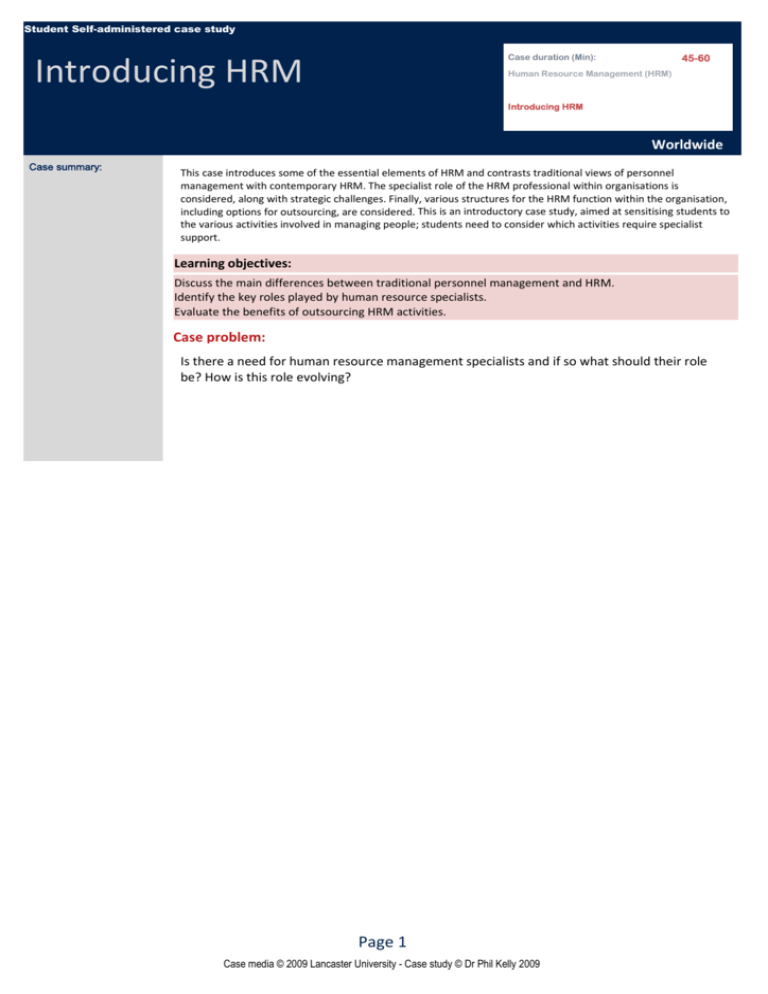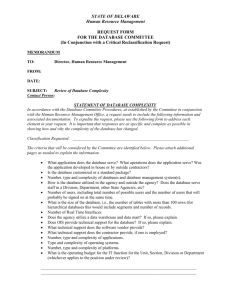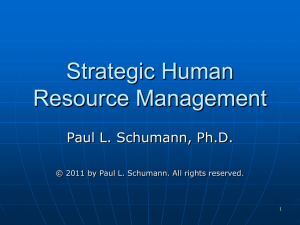Case study 121 | Introducing HRM for students to self administer
advertisement

Student Self-administered case study 45-60 Case duration (Min): Introducing HRM Human Resource Management (HRM) Introducing HRM Worldwide Case summary: This case introduces some of the essential elements of HRM and contrasts traditional views of personnel management with contemporary HRM. The specialist role of the HRM professional within organisations is considered, along with strategic challenges. Finally, various structures for the HRM function within the organisation, including options for outsourcing, are considered. This is an introductory case study, aimed at sensitising students to the various activities involved in managing people; students need to consider which activities require specialist support. Learning objectives: Discuss the main differences between traditional personnel management and HRM. Identify the key roles played by human resource specialists. Evaluate the benefits of outsourcing HRM activities. Case problem: Is there a need for human resource management specialists and if so what should their role be? How is this role evolving? Page 1 Case media © 2009 Lancaster University - Case study © Dr Phil Kelly 2009 First, if you are taking a taught management course then consult with your tutor and ensure that the case has not been scheduled into a teaching class or tutorial. If it has not: 1. Play/ read the media associated with the case. You may need to access the Internet and enter a URL to locate any video clips. 2. Attempt the Case study questions. Consider attempting the case study as a group exercise; you could form a study group with fellow students. 3. Check the suggested answers - remember these are suggestions only and there are often many possible answers. Discuss questions and answers with other students. 4. If you feel your answer(s) were weak then consider reading the relevant suggested readings again (also see the case study suggested references). URL/ Media description Title/ Media type Martin Hird: Proving HR's worth - the 'Golden Triangle' Film http://www.youtube.com/watch?v=dQ1dbMpA9vQ&feature=player_embedded Martin Hird (Executive Director, Centre for Performance‐Led HR at Lancaster University) talks us through the concept of the Golden Triangle. Anthony Hesketh: Proving HR's worth - is HR at a crossroads? Film http://www.youtube.com/watch?v=7z_wYy9QVqg&feature=player_embedded Anthony Hesketh asks: is HR at a crossroads? NOTES: Page 2 Case media © 2009 Lancaster University - Case study © Dr Phil Kelly 2009 Case study questions... Pre/During/After class Action 1 MANAGING PEOPLE : 2 ROLE PLAYED BY THE HR FUNCTION IN MANAGING PEOPLE : 3 STRATEGIC CHALLENGE : 4 HRM STRUCTURES : 5 During In groups, brainstorm key activities associated with managing people in organizations – what activities must be undertaken when managing people? During In order to maximize the return on investment from the organization's Human Capital, larger firms establish a Human Resources (personnel) function. Human resource management (HRM) aims to improve the productive contribution of individuals – it is about people and their ability to be economically productive, to enhance organisational performance. We now turn our attention to the role played by the HR function in managing people. What is the role of the HR function in the organization? Of the activities listed in the previous question, which do you believe require attention from an HR specialist and which should be undertaken by line management? In your answer, you should critically evaluate how the role of specialists has changed-starting with the industrial age, through scientific management to the intangible economy (from personnel to HRM). During Martin Hird discusses the ‘golden triangle’ as a small group of influential senior managers who focus on strategic issues and key company challenges. HR Directors are typically members of this group. Suggest how the HR function might embrace the strategic challenge of developing the company’s HC for sustainable competitive advantage. During Research by Sisson and Scullion (1985) revealed that some corporations had large corporate personnel departments undertaking a wide range of activities, whilst others had a small team of corporate personnel executives or a single executive, and one corporation had no corporate personnel department at all. With reference to centralisation, identify possible HRM structures. HR OUTSOURCING : During Anthony Hesketh believes that HR has options – for example, it may outsource . Companies may consider HR outsourcing an important part of maximising their performance. Outsourcing can be defined as the delegation of one or more HR business processes to an external provider who then owns, manages and administers the selected HR processes, based on defined and measurable performance metrics. What do you think are the advantages and disadvantages of outsourcing the HR function? What actions and decisions must be taken when selecting a suitable outsourcing partner? Page 3 Case media © 2009 Lancaster University - Case study © Dr Phil Kelly 2009 Answers... PERSONNEL MANAGEMENT Administrative systems and processes for managing workers, including job descriptions, employee selection, rewards, training and appraisal. HUMAN RESOURCE MANAGEMENT (HRM) A range of management activities which aim to achieve organizational objectives through effective use of employees. SPECIALIZATION The degree to which an organization's activities are divided into specialist roles. SCIENTIFIC MANAGEMENT a school of management theory dating from the early twentieth century; more analytical and systematic than ‘scientific’ as such, sometimes referred to (pejoratively) as Taylorism, after Frederick Taylor who was influential in founding its principles. LINE MANAGER Every employee reports to a line manager – their boss. LINE ORGANISATION Relates to those functions within an organisation concerned with specific responsibility for achieving the objectives of the organisation and to those people in the direct chain of command. Question/ Answer 1 MANAGING PEOPLE : In groups, brainstorm key activities associated with managing people in organizations – what activities must be undertaken when managing people? Possible activities include: determining staffing needs, determining whether to use temporary staff or hire employees to fill these needs, recruiting and training the best employees, allocating and supervising work, motivation, employee records and personnel policies, ensuring high performance, managing employee payroll, benefits and compensation, managing employee relations, unions and collective bargaining, ensuring equal opportunity, dealing with discrimination, dealing with performance issues, and ensuring HR practices conform to various regulations. 2 ROLE PLAYED BY THE HR FUNCTION IN MANAGING PEOPLE : In order to maximize the return on investment from the organization's Human Capital, larger firms establish a Human Resources (personnel) function. Human resource management (HRM) aims to improve the productive contribution of individuals – it is about people and their ability to be economically productive, to enhance organisational performance. We now turn our attention to the role played by the HR function in managing people. What is the role of the HR function in the organization? Of the activities listed in the previous question, which do you believe require attention from an HR specialist and which should be undertaken by line management? In your answer, you should critically evaluate how the role of specialists has changed‐starting with the industrial age, through scientific management to the intangible economy (from personnel to HRM). The evolving role of the Personnel, now HR function, see Miles and Snow (1984) - (1) during the industrial age, employees were managed by company owners; as organisations grew, personnel departments started to appear in functional organisations and had an administration role; (2) during the first half of the 20th century, principles of scientific management gained a hold and the role of specialists was emphasised. Personnel departments became responsible for recruitment and employee development and as a centralised department, harmonised practices; (3) the personnel function grew in scope, becoming responsible for planning as well as recruitment and selection; (4) during the information age, the HR profession was established and given a greater strategic role and by (5) the turn of the millennium (the intangible economy) human resources, through their knowledge and creativity amongst other things, were seen as a key source of sustainable competitive advantage. Consequently, the HRM specialist role became more strategic and significant. The goal of HRM is to help an organization meet strategic goals by attracting, and retaining employees and also to manage them effectively. HRM is therefore concerned with the strategic management of human resources to achieve a competitive advantage. A variety of activities may be associated with HRM: Strategic HR Management, Equal Employment Opportunity (EEO), Resourcing (Staffing), Training and Development, Reward and Recognition, Health, Safety, & Security, and Employee (Labour) Relations. Bartlett and Ghoshal (2002) discuss the evolving (leading strategic) role of HR and the implications for HR Professionals. In the 1980s their function was typically supportive and administrative. The role of HR staff was to ensure that recruitment, training, benefits administration and the like supported the well-defined strategic and operational agenda. When strategic priorities became more organizationally focused in the 1990s, humanresources managers were increasingly included in the strategic conversation, often to help define and develop the company's core competencies -- and almost always to align the organizational design and management skills to support those strategic assets (2002:37). Now, as companies move into the war for talent and as individuals with specialized knowledge, skills and expertise are recognized as the scarce strategic resource, HR professionals must become key players in the design, development and delivery of a company's strategy. The key HR activity in the evolving role of Human Resources suggested by Bartlett and Ghoshal (2002:37) is building human capital as a core source of competitive advantage. This presents a central role for HR in Strategy. Page 4 Case media © 2009 Lancaster University - Case study © Dr Phil Kelly 2009 3 STRATEGIC CHALLENGE : Martin Hird discusses the ‘golden triangle’ as a small group of influential senior managers who focus on strategic issues and key company challenges. HR Directors are typically members of this group. Suggest how the HR function might embrace the strategic challenge of developing the company’s HC for sustainable competitive advantage. Bartlett and Ghoshal (2002) outline three major strategic tasks that align the HR function with the strategic challenge of developing the company’s HC for sustainable competitive advantage: Building (HR systems, processes and culture) Linking (developing social networks – vital to knowledge management) Bonding (creating a sense of identity and belonging) The building task includes identifying opportunities to gain competitive advantage through hiring decisions (locating, attracting, developing, rewarding and retaining the best people). In the linking role, HR professionals take the lead in developing the social networks that are vital to the capture and transfer of knowledge; they break down bureaucracy and unlock core competencies. Finally, HR must help management develop the engaging, motivating and bonding culture necessary to attract and retain talented employees. 4 HRM STRUCTURES : Research by Sisson and Scullion (1985) revealed that some corporations had large corporate personnel departments undertaking a wide range of activities, whilst others had a small team of corporate personnel executives or a single executive, and one corporation had no corporate personnel department at all. With reference to centralisation, identify possible HRM structures. Several types of IHRM structures, they include: Totally centralised; Centralised HR policy development | regional input in implementation; Corporate group and Divisional HR units. More recently, Andolšek and Štebe (2005) studied the shift of HRM tasks from central HRM departments to managers themselves, a phenomenon known as devolution - a business model of HRM, where line managers are seen as the key decision-makers in HR issues. Poole and Jenkins (1997), cited in Andolšek and Štebe (2005), listed several reasons why the decentralization of responsibility to the line has been viewed as a key characteristic of the modern form of HRM. First is the effective implementation of HR strategy only through the line and second is the supposition that line management is critical for the high commitment and motivation of the employees (see previous chapter). Purcell and Ahlstrand (1994) argued that the overall shift to decentralization of key activities has meant that corporate HR managers are playing more of a monitoring and control function, with the emphasis on the co-ordination of divisional and plant personnel around a more broadly defined group policy or objective, and they suggest that the need for a corporate HR department is less than it appeared a decade ago. With a trend to devolve HR management activities to line managers, the role of corporate human resource management is reduced to the management of key international assignments in some MNC’s. Page 5 Case media © 2009 Lancaster University - Case study © Dr Phil Kelly 2009 5 HR OUTSOURCING : Anthony Hesketh believes that HR has options – for example, it may outsource . Companies may consider HR outsourcing an important part of maximising their performance. Outsourcing can be defined as the delegation of one or more HR business processes to an external provider who then owns, manages and administers the selected HR processes, based on defined and measurable performance metrics. What do you think are the advantages and disadvantages of outsourcing the HR function? What actions and decisions must be taken when selecting a suitable outsourcing partner? Advantages of outsourcing the HR function Reduced costs/ increased efficiency, Improved HR IT systems, Improved HR Metrics, Access to HR expertise (not available internally), Increased flexibility, Reduced risk, Frees up HR resources from ‘factory tasks’ allowing them to operate more strategically. Disadvantages of outsourcing : Contracts tend to be long (5-10years), Loss of local processes and knowledge, Detachment from employees – no upward feedback, Standardisation of processes in line with provider preferences not organizational preferences (cultural misfit), What actions and decisions must be taken when selecting a suitable outsourcing partner? Understand existing HR position – costs, responsibilities, levels of service, Vision of HR requirements for future, Speak with other organizations serviced by the outsource provider, Consider cultural and geographical factors, Develop clear metrics within a service level agreement (SLA), Case study references Bartlett, C. and Ghoshal, S. (2002) 'Building Competitive Advantage Through People', MIT Sloan Management Review, Winter2002, Vol. 43 Issue 2, p. 34 ‐ 41. Cole, G A. and Kelly, P P. (2011) 'Management Theory and Practice', Ed. 7. Cengage EMEA. Miles, R E. and Snow, C C. (1984) 'Designing Strategic Human Resources Systems', Organizational Dynamics, Summer84, Vol. 13 Issue 1, p. 36 ‐ 52. Price, A. (2007) 'Human Resource Management in a Business Context', Ed. 3. Cengage Learning EMEA. Scullion, H. and Starkey, K. (2000) 'In search of the changing role of the corporate human resource function in the international firm', International Journal of Human Resource Management, Dec2000, Vol. 11 Issue 6, p. 1061 ‐ 1081. Page 6 Case media © 2009 Lancaster University - Case study © Dr Phil Kelly 2009









